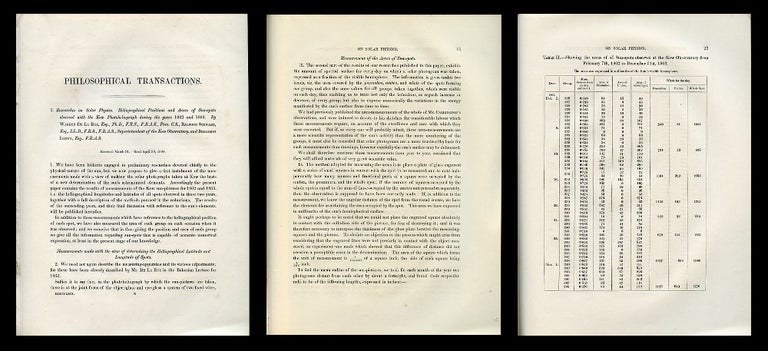Researches on Solar Physics. Heliographical Positions and Areas of Sun-Spots observed with the Kew Photoheliograph during the Years 1862 and 1863. Received March 31, - Read April 30, 1868 extracted from Philosophical Transactions of the Royal Society, Vol. 159, Part I, 1870, pp. 1-110
London: Taylor and Francis, 1870. 1st Edition. FIRST EDITION EXTRACT WITH TWO PLATES OF ONE OF THE EARLIEST PAPERS ABOUT PHOTOGRAPHING THE SUN. This paper is one of a series of influential papers de la Rue, Stewart, and Loewy published regarding their work at the Kew Observatory. We offer de la Rue’s 1860/1862 “Bakerian Lecture On Some Total Solar Eclipse” separately.
Warren de la Rue was a British chemist and astronomer whose efforts “helped make photography one of astronomy’s greatest tools” (Stanford Solar Center). de la Rue adapted wet plate photography to lunar photography, pioneering “the application of photography to the study of the Moon and Sun [and] in the process demonstrating the value of an equatorially mounted, clock-driven reflecting telescope as a camera, techniques that greatly accelerated the evolution of the new science of astrophysics” (Biographical Encyclopedia of Astronomers, 284).
In the mid-19th century, John Herschel spoke openly about the importance of a daily photographic record of sunspots. In 1854 and at Herschel’s urging, the Royal Society granted support to de la Rue to invent a telescope specifically designed for photographing the Sun. de la Rue did just that. His invention, the photoheliograph, was the first astronomical instrument constructed for the photography of celestial objects [and it is described in detail in this paper]. Known as the Kew Photoheliograph, de la Rue’s instrument included an achromatic objective, a clockwork mechanism, and a Huygenian eyepiece (one actually constructed by Huygens in the 17th century and presented to the Society by Newton). In 1860 de la Rue took his invention at his own expense on an expedition to Rivabellosa Spain with the hope of photographing a total solar eclipse to occur on July 18th. The photographs de la Rue took represent the first extended series of photographic observations of the Sun over a solar cycle. Item #844
CONDITION & DETAILS: London: Taylor & Francis. 4to. Extracted from the Philosophical Transactions of the Royal Society, Volume 159, 1870. 11 x 8.75 inches. Complete; in-text tables and illustrations throughout; 2 plates, both foxed. Other than the plates, all 110 pages are bright and very clean (in the photo the toning on the pages looks different, but that is due to the scanner light; very little difference in toning is visible to the eye). Very good condition.
Price: $80.00

